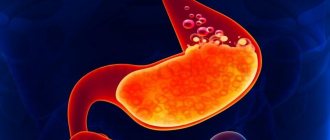Dysbacteriosis: medical certificate
Dysbacteriosis - disturbance of intestinal microflora
Dysbacteriosis is an imbalance of opportunistic, pathogenic and non-pathogenic microflora.
As long as non-pathogenic bacteria predominate in the body, and all others are within normal physiological limits, the gastrointestinal tract system works without failures, the reproductive system does not bother, and aphthae and seizures do not form in the oral cavity.
In various unfavorable situations, the composition of the microflora changes. The reasons may be treatment with aggressive drugs, stress, poor nutrition, and hormonal changes.
Most often, when talking about dysbiosis, we mean its intestinal form. Symptoms of microflora disorders in the gastrointestinal tract include pain, pain, diarrhea and constipation, and impaired digestion of food.
If the bacterial balance in the vagina is disturbed, then the woman is bothered by an unpleasant odor, discharge, pain and burning. Dysbacteriosis of the oral cavity is similar in symptoms to pathologies of the reproductive system. The patient is bothered by bad breath, dry mucous membranes, ulcers and sticking in the corners of the lips may appear.
Treatment tactics, general principles
Medicines for dysbiosis
To make a diagnosis, you should undergo a physical examination by a doctor. Depending on the manifestations of the disease, this may be a pediatrician, therapist, gastroenterologist, gynecologist or dentist.
An imbalance of microflora must be confirmed by laboratory tests. For problems with the gastrointestinal tract, this is a stool analysis, for the oral cavity - bacterial cultures, for the reproductive system - gynecological smears, bacterial cultures, PCR tests.
Bacteriophages (from the words “bacteria” and the Greek phagos - devouring; BF), or phages, are specific bacterial viruses that cause their lysis (destruction of cells) or change their properties. They were first discovered by microbiologists F. Twort (1915) in Great Britain and F. d'Herelle (1917) in France. However, it was possible to study their morphology only after the invention of the electron microscope.
Biology of bacteriophages
The wide distribution of BFs in nature is associated with the ubiquity of their main hosts, bacteria. BFs can infect not only bacteria, but also fungi and protozoa, which is why they are also called phages. According to the degree of specificity, they distinguish: polyvalent BPs that interact with related species of bacteria; monovalent BFs that interact with bacteria of a certain type; typical BFs that interact with individual types (variants) of a given type of bacteria.
BFs consist of a protein - a capsid that protects one type of nucleic acid (DNA or RNA, single or double-stranded). There are BFs with a long process, having a contractile or non-contractile sheath, as well as BFs with short processes, analogues of processes, without processes and filamentous (Fig. 1, 2). The size of the BF ranges from 20 to 800 nm (in filamentous forms). BFs, which have the shape of a spermatozoon, reach up to 200 nm in length, consist of a tail process and an icosahedral type head containing nucleic acid. The capsid of the head and the sheath of the tail process of the BP consist of polypeptide subunits arranged according to icosahedral (head) or helical (process) type of symmetry. The tail process has a hollow tube (rod) inside, through which, during infection, the phage nucleic acid passes from the head into the bacterium. The process sheath ends in a hexagonal basal plate with spines from which fibrils (threads) extend. The basal lamina and tail fibrils are involved in the attachment of BP to the bacterial cell. Not all FDs have basal plates and tail fibrils. Depending on the life cycle, BFs can be virulent (lytic) or moderate.
Virulent (lytic) BPs for penetration into bacteria are adsorbed on specific cell receptors, including lipopolysaccharide, lipoprotein, teichoic acids, proteins, or even pili. The specificity of the receptors means that BP can only infect certain bacteria. Once in the bacterium, BF reproduces, forming 200–500 phage particles and causing the death of the bacterium. This is a productive (lytic) type of interaction. BFs with a contractile sheath are adsorbed on the cell wall with the help of fibrils of the tail process. The sheath of the tail process contracts, and the rod, with the help of enzymes (lysozyme), seems to drill through the cell membrane. Through the channel of the BF tube, the nucleic acid is injected from the head into the bacterial cell, and the BF capsid remains outside the bacterium (Fig. 2). The nucleic acid of BF directs the synthesis of its enzymes. In this case, the host DNA and RNA are inactivated. The BF nucleic acid replicates and directs the synthesis of new capsid proteins. Self-assembly of the capsid around the phage nucleic acid and the formation of BFs occur, which come out of the bacterium as a result of its lysis, expulsion, or in some cases, budding. 200–1000 new BPs are released from the bacterium, which infect other bacterial cells.
Moderate BFs interact with bacteria in a productive or integrative manner. The productive type of temperate phage, like virulent phages, ends with the lysis of bacteria. With the integrative type, the DNA of a temperate phage is integrated into the bacterial chromosome and replicates synchronously with the bacterial genome without causing its lysis (transmitted when the bacterium divides). The phage DNA embedded in the chromosome of a bacterium is called a prophage, and the bacterial culture is called lysogenic, the process itself is called lysogeny (from the Greek lysis - decomposition, genea - origin).
The chromosome of the temperate phage lambda, introduced into the bacterium, causes either lysis or lysogenization (the temperate phage DNA that has penetrated into the bacterium takes the shape of a ring and integrates into a strictly defined region of the chromosome). Ultraviolet irradiation induces a lytic process with the release of phage. In lysogeny, phages are not formed as a result of “switching off” phage genes by a repressor encoded by one phage gene.
Prophages can be derepressed spontaneously or under the influence of inducing agents (ultraviolet rays, mitomycin C, etc.) and excluded from the chromosome. This process ends with the production of phages (prophage induction) and lysis of bacteria. The prophage imparts new properties to the bacterium, which is called phage conversion (Latin: conversio - transformation). The morphological, cultural, biochemical, antigenic and other properties of bacteria can be converted. For example, the presence of a prophage in Vibrio cholerae determines its ability to produce cholera exotoxin.
BF is used for the prevention and treatment of infections, as well as for diagnostics (for example, for phage typing to identify the source of infection). In addition, BFs are used in genetic engineering as vectors transferring DNA sections; Natural gene transfer between bacteria through transduction is also possible.
Phage typing is one of the methods of epidemiological marking. Used to identify the source of infection. Isolation of bacteria of the same phagovar from different patients indicates a common source of their infection. During intraspecific identification of bacteria, i.e., when determining the phagovar (phagotype) of bacteria using phage typing, drops of various diagnostic type-specific phages are applied to a Petri dish with a dense nutrient medium seeded with a pure culture of the pathogen in the form of a “lawn”. Bacteria sensitive to the phage are lysed (a sterile spot, “plaque”, or so-called negative phage colony is formed).
BF is a unique phenomenon; they participate in various processes:
- in the transmission of drug resistance during transduction, especially in staphylococci;
- lysogenic conversion leads to the acquisition of new characteristics of bacteria;
- a random insertion into a bacterial chromosome can cause an insertional mutation;
- in epidemiological typing of bacteria (phage typing);
- in lambda BF – a model system for studying latent infection;
- BFs are used in genetic engineering as vectors and gene libraries;
- BFs are responsible for the natural removal of bacteria; used to prevent and treat certain infections.
Obtaining effective therapeutic and prophylactic BPs is associated with a careful and constant search for strains with a wide spectrum (valency) of action on bacteria and a high degree of their lytic activity. The lytic activity and, consequently, the therapeutic and preventive effectiveness of BF preparations depend on the species, infraspecific affiliation of the pathogen, its receptor characteristics and factors of its microenvironment. For example, antibodies and other humoral proteins can block the binding sites of bacteria with BF, which excludes the possibility of parenteral administration of the latter. In addition, the rapid development of bacterial resistance to the used BFs is possible. To obtain a therapeutic effect in case of unfavorable bacterial associations, BF preparations are produced either as polyvalent ones, directed against various species and serovars of one pathogen, or combined, containing BF against various types of pathogen.
BFs do not cause adverse reactions and do not disrupt normal microflora. With dysbacteriosis, intestinal dysfunction caused by the development of local inflammatory processes, suppression of resident microflora, a number of opportunistic microorganisms and transient microflora are activated. These circumstances raise the importance of selective decontamination carried out using targeted antibiotics and lytic BPs.
BF, having specific action against certain pathogens of acute intestinal infections, can also contribute to the development of oral tolerance. It is known that the human body exhibits oral (regional) tolerance to its own normal microflora. This tolerance is due to the blockade of activation of signaling receptors (for example, toll-like receptors - TLR, etc.) to components of the human microflora and the activity of regulatory T lymphocytes (Treg), which in turn are activated by NKT cells (natural killer T cells). Components (patterns) of BP and the bacteria destroyed by it can activate certain signal receptors of body cells, stimulating the synthesis of antimicrobial peptides that suppress the development of the most aggressive microbes (Fig. 3). Failure of oral tolerance leads to the development of various disorders, including chronic gastritis, Crohn's disease, ulcerative colitis, necrotizing enterocolitis in children, gastric and duodenal ulcers.
BF preparations are stored at a temperature of 2–10 °C in a dry, dark place. BF are sensitive to ultraviolet rays; even their short exposure to light leads to loss of lytic activity. To protect BF from the action of gastric juice, they are produced in capsules or tablets coated with an acid-resistant coating. The protective coating material is non-toxic cellulose, esterified with acetic and phthalic acids, forming a smooth transparent film. For children, due to problems swallowing tablets, a pectin coating is used. Pectin, enveloping BF, protects them from the destructive effects of gastric juice.
Normalization of microflora and the possible participation of BP in the maintenance of colonization resistance and oral tolerance ensure stabilization of the humoral and cellular components of immunity. Occasionally, the use of BF coincides with a deterioration in the quality of stool due to the massive death of bacteria sensitive to it. In this case, to reduce intoxication, it is advisable to prescribe enterosorbent at night - no earlier than 3-4 hours after the last dose of BF.
Bacteriophage preparations against intestinal pathogens
Intesti-bacteriophage liquid contains sterile filtrates of phagolysates of Shigella (S. flexneri serovars 1, 2, 3, 4, 6 and S. sonnei), Salmonella (S. paratyphiA, S. paratyphiB, S. typhimurium, S. choleraesuis, S. infantis , S. oranienburg, S. enteritidis), enteropathogenic Escherichia coli of the most etiologically significant serovars (Escherichia coli O111, O55, O26, O125, O119, O128, O18, O44, O25, O20), Proteus (vulgaris and mirabilis), staphylococci, enterococci and pseudomonas aeruginosa (Pseudomonas aeraginosa). Intesti-bacteriophage (Bacteriophagum intestinalis fluidum) is a transparent yellow liquid of varying intensity.
The drug is intended for the treatment and prevention of diseases of the gastrointestinal tract caused by the above bacteria, their combination (including bacterial dysentery, salmonellosis, typhoid fever, paratyphoid fever, dysbacteriosis, enterocolitis, colitis, dyspepsia). It is prescribed in the acute period of the disease: monotherapy for mild and erased forms, for bacterial excretion; combination therapy with other antibacterial agents (for moderate cases) or immunomodulators (for prolonged bacterial excretion). The key to the effectiveness of using intesti-bacteriophage is to determine the phage sensitivity of the pathogen and early use of the drug, which is prescribed orally or rectally using an enema. Intesti-bacteriophage is administered orally 3–4 times a day on an empty stomach 1.0–1.5 hours before meals for 7–10 days and in a single dose: children up to 6 months – 5–10 ml, 6–12 months – 10 –15 ml, 1–3 years – 15–20 ml, over 3 years – 20–40 ml (see table). For children in the first months of life, the prescribed drug is diluted with boiled water 2 times in the first two days. If there are no side complications (regurgitation, skin rashes), the drug is prescribed undiluted. Before taking intesti-bacteriophage, children over 3 years of age and adults are prescribed a solution of baking soda (0.5 teaspoon per 0.5 glass of water) or alkaline mineral water. In the absence of colitic syndrome, the drug is prescribed rectally once a day after bowel movement.
Bacteriophage dysentery polyvalent (in acid-resistant tablets and suppositories) contains sterile filtrates of Shigella phagolysates (S. flexneri and S. sonnei). Used from 6 months of age for the treatment and prevention of bacterial dysentery. For treatment, it is used orally 3 times a day an hour before meals for 5–7 days and in a single dose: for children from 6 months to 3 years – 1 tablet, 3–8 years – 1–2 tablets, over 8 years – 2–3 tablets. In case of mild colitis syndrome and during the period of convalescence, the third oral dose of BF can be replaced by its rectal use: from 6 months to 3 years – 20–40 ml, from 3 to 8 years – 40–60 ml, over 8 years – 60–80 ml.
For preventive purposes, it is recommended to take the drug daily depending on age: 10–40 ml or 1–2 tablets.
Salmonella bacteriophage of groups A, B, C, D, E in tablets with acid-resistant coating, in suppositories, liquid contains sterile filtrates of Salmonella phagolysates (S. paratyphi A, S. paratyphi B, S. typhimurium, S. heidelberg, S. newport, S. choleraesuis, S. oranienburg, S. infantis, S. dublin, S. enteritidis, S. anatum, S. newlands). For treatment, it is used orally 3 times a day an hour before meals for 7–10 days and in a single dose: for children 6–12 months – 0.5 tablets; 1–3 years – 0.5–1.0; 3–8 years – 1.0 each; over 8 years old – 2 tablets. The third oral dose can be replaced by rectal administration of the drug. For preventive purposes, BF is prescribed for children 1 tablet and for adults 2 tablets 2 times a week.
Bacteriophage typhoid in tablets with an acid-resistant coating contains a sterile filtrate of the phagolysate of Salmonella typhoid (S. typhi). The drug is prescribed for the prevention of typhoid fever orally one hour before meals for children from 6 months to 3 years old, 1 tablet, and over 3 years old and adults - 2 tablets 1 time in 3 days or every day until recovery.
Bacteriophage coliproteus liquid contains sterile filtrates of phagolysates of enteropathogenic (diarrheagenic) Escherichia coli (Escherichia coli of the most common serological groups O20, O26, O33, O44, O55, O111, O119, O26, O124, O125, O127, O151), Proteus vulgaris and Proteus mirabilis. The drug is intended for the treatment and prevention of diseases caused by the above bacteria, as well as dysbacteriosis.
The scope of application of other bacteriophage preparations is diverse; they are used both for topical application (“wound” bacteriophages) and for oral or rectal administration, including depending on the form of release:
- Klebsiella pneumoniae bacteriophage purified liquid;
- Klebsiella bacteriophage polyvalent purified liquid;
- bacteriophage coli liquid;
- Proteus bacteriophage liquid;
- bacteriophage pseudomonas aeruginosis (pseudomonas) liquid;
- Salmonella bacteriophage ABCDE groups in suppositories;
- Salmonella bacteriophage ABCDE group liquid;
- Salmonella bacteriophage ABCDE groups liquid and dry with acid-resistant coating;
- staphylococcal bacteriophage in aerosol packaging;
- staphylococcal bacteriophage in suppositories;
- staphylococcal bacteriophage for injection, liquid;
- bacteriophage staphylococcal liquid;
- bacteriophage streptococcal liquid.
In conclusion, it should be noted that BF and BF preparations are characterized by many positive aspects, they are:
- safe, including non-toxic, for humans;
- highly stable during long-term storage;
- have strict specificity of action on certain types of bacteria and are effective both as monotherapy and in combination with antibiotics;
- do not disrupt normal microflora;
- capable of self-reproduction and self-regulation of numbers.
Information about the authors: Anatoly Sergeevich Bykov – Doctor of Medical Sciences, Professor of the Department of Microbiology, Virology and Immunology of the State Educational Institution of Higher Professional Education “First Moscow State Medical University named after. THEM. Sechenov” of the Ministry of Health and Social Development of the Russian Federation. Tel., e-mail; Bykov Sergey Anatolyevich – Candidate of Medical Sciences, assistant at the Department of Clinical Immunology and Allergology of the State Educational Institution of Higher Professional Education “First Moscow State Medical University named after. THEM. Sechenov” of the Ministry of Health and Social Development of the Russian Federation.
Therapeutic tactics for vaginal dysbiosis
Dysbacteriosis of the reproductive organs develops due to damage to the vagina by opportunistic flora. The main inhabitants of the genital organs are lactic acid rods. In normal condition, they make up 95% of the vaginal flora. The rest are opportunistic bacteria.
For a number of reasons - antibiotic treatment, stress, hormonal changes - opportunistic flora begins to actively multiply. The woman experiences discharge and there may be itching and burning in the vagina. In a smear with normal leukocyte counts, a mixed or fungal or coccal flora is determined.
Therapeutic tactics are similar to the treatment of intestinal dysbiosis:
- Suppression of pathogenic flora with antibiotics, antifungal or antibacterial drugs in the form of vaginal suppositories, creams, tablets. In difficult cases, oral or injection antiseptics are indicated.
- Popular drugs in gynecological practice are those based on metronidazole, clindamycin, povidone-iodine, and fluconazole.
- At the second stage of treatment, the administration of drugs that stimulate the production of lactic acid is indicated. These can be probiotics and symbiotics for oral administration - for example, Ecobiol capsules - or suppositories for vaginal use.
- Additionally, it is recommended to change your diet, normalize your sex life, and monitor hygiene. In difficult cases, a comprehensive examination is indicated with determination of hormonal status, bacterial culture of discharge, and PCR diagnostics.
Phage display
Nowadays, bacteriophages are also widely used as simple systems for producing proteins with desired properties. We are talking about one developed in the 1980s. extremely effective molecular selection technique - phage display
. This term was proposed by the American J. Smith, who proved that, based on E. coli bacteriophages, it is possible to create a viable modified virus carrying a foreign protein on its surface. To do this, the corresponding gene is introduced into the phage genome, which is fused with the gene encoding one of the surface viral proteins. Such modified bacteriophages can be isolated from a mixture with wild-type phages due to the ability of the “foreign” protein to bind to specific antibodies (Smith, 1985).
Two important conclusions emerged from Smith's experiments: first, using recombinant DNA technology, it is possible to create hugely diverse populations of 106–1014 phage particles, each of which carries different protein variants on its surface. Such populations are called combinatorial phage libraries
. Secondly, by isolating a specific phage from a population (for example, one that has the ability to bind to a specific protein or organic molecule), this phage can be propagated in bacterial cells and an unlimited number of descendants with specified properties can be obtained.
Schematic diagram of the biopenning procedure—selection of highly specific recombinant antibodies to a specific target antigen from a combinatorial phage display library based on filamentous bacteriophages. From: (Tikunova, Morozova, 2009)
With the help of phage display, proteins are now produced that can selectively bind to therapeutic targets, for example, those exposed on the surface of the M13 phage, which are capable of recognizing and interacting with tumor cells. The role of these proteins in the phage particle is to “package” the nucleic acid, so they are well suited for creating gene therapy drugs, only in this case they form a particle with a therapeutic nucleic acid.
Today, there are two main areas of application of phage display. Peptide-based technology is used to study receptors and map antibody binding sites, create immunogens and nanovaccines, and map substrate binding sites of enzyme proteins. Technology based on proteins and protein domains - for selecting antibodies with specified properties, studying protein-ligand interactions, screening expressed fragments of complementary DNA and targeted modifications of proteins.
Using phage display, it is possible to introduce recognition groups into all types of surface viral proteins, as well as into the main protein that forms the body of the bacteriophage. By introducing peptides with specified properties into surface proteins, it is possible to obtain a whole range of valuable biotechnological products. For example, if this peptide imitates the protein of a dangerous virus or bacteria, recognized by the immune system, then such a modified bacteriophage is a vaccine that can be produced simply, quickly and safely.
If the terminal surface protein of the bacteriophage is “addressed” to cancer cells, and reporter groups (for example, fluorescent or magnetic) are attached to another surface protein, then a tool for detecting tumors will be obtained. And if a cytotoxic drug is also added to the particle (and modern bioorganic chemistry makes this easy to do), you will get a medicine that targets cancer cells.
One of the important applications of the phage protein display method is the creation of phage libraries of recombinant antibodies, where antigen-binding fragments of immunoglobulins are located on the surface of fd or M13 phage particles. Libraries of human antibodies are of particular interest, since such antibodies can be used in therapy without limitation. In recent years, about a dozen therapeutic antibodies constructed using this method have been sold on the US pharmaceutical market alone.
Dysbacteriosis of the oral cavity
Medicines come in different forms of release
Digestion begins in the mouth. This part of the gastrointestinal tract system is distinguished by its own microflora, the disruption of which causes stomatitis, aphthae, ulcerations of the mucous membrane and skin in the corners of the mouth - the so-called jams.
The reasons for the development of flora imbalance are similar to other forms of dysbiosis. This includes a history of aggressive treatment, violation of hygiene rules, complex dental procedures, wearing braces and dentures.











